MGT300 Case Study: Analyzing Change Management at HCL Technologies
VerifiedAdded on 2022/09/15
|12
|2643
|19
Case Study
AI Summary
This assignment analyzes the change management strategies implemented at HCL Technologies under the leadership of CEO Vineet Nayar, as detailed in the Harvard Business Review case study. The analysis examines the internal and external drivers of change, including the increasing competition in the IT services industry and the need to address internal cultural issues. The assignment explores the emotions associated with the change, considering the perspectives of senior managers and employees, and how Nayar addressed them. It identifies the underlying perspectives of change, such as the hierarchical organizational structure and the need for greater employee involvement and transparency. The nature of the change is described as transformational and reactive, driven by market pressures and the desire to improve market share. The assignment outlines the belief in the change process, highlighting the success of Nayar's 'Employees First, Customers Second' approach. Finally, it recommends alternative change interventions, such as techno-structural changes and increased employee involvement, to further enhance the change management process. The case study demonstrates how HCL adapted to market changes and improved employee engagement.
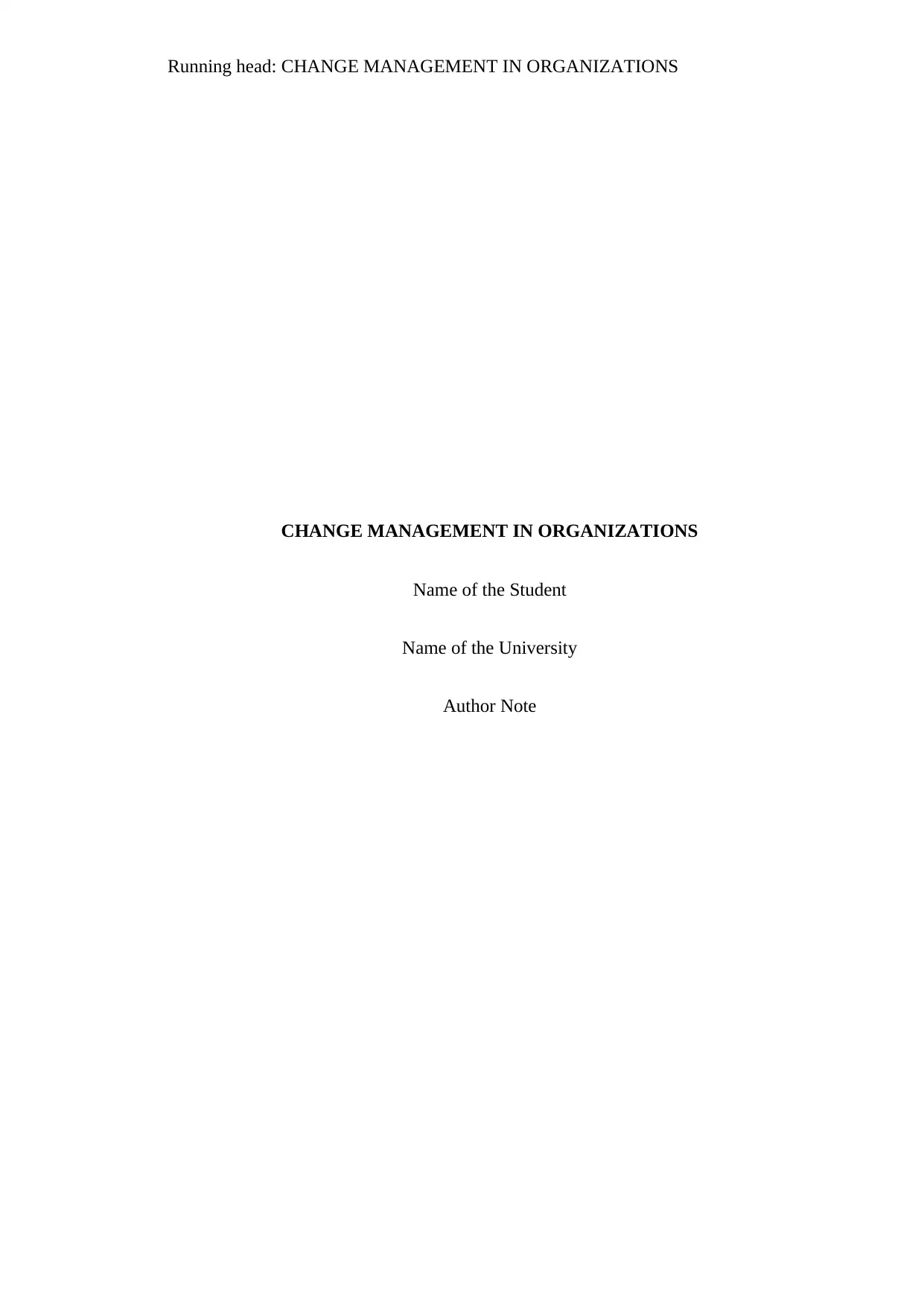
Running head: CHANGE MANAGEMENT IN ORGANIZATIONS
CHANGE MANAGEMENT IN ORGANIZATIONS
Name of the Student
Name of the University
Author Note
CHANGE MANAGEMENT IN ORGANIZATIONS
Name of the Student
Name of the University
Author Note
Paraphrase This Document
Need a fresh take? Get an instant paraphrase of this document with our AI Paraphraser
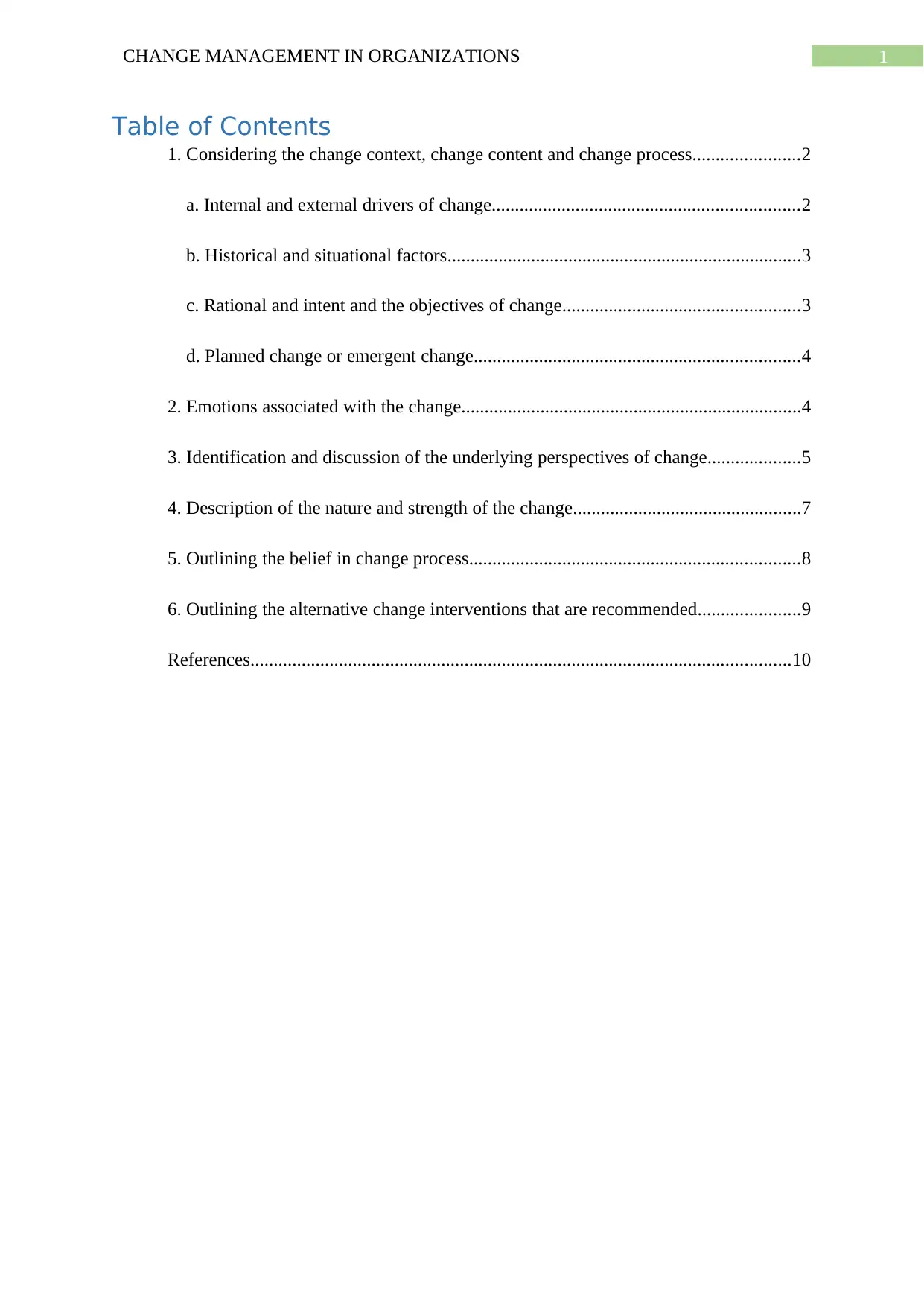
1CHANGE MANAGEMENT IN ORGANIZATIONS
Table of Contents
1. Considering the change context, change content and change process.......................2
a. Internal and external drivers of change..................................................................2
b. Historical and situational factors............................................................................3
c. Rational and intent and the objectives of change...................................................3
d. Planned change or emergent change......................................................................4
2. Emotions associated with the change.........................................................................4
3. Identification and discussion of the underlying perspectives of change....................5
4. Description of the nature and strength of the change.................................................7
5. Outlining the belief in change process.......................................................................8
6. Outlining the alternative change interventions that are recommended......................9
References....................................................................................................................10
Table of Contents
1. Considering the change context, change content and change process.......................2
a. Internal and external drivers of change..................................................................2
b. Historical and situational factors............................................................................3
c. Rational and intent and the objectives of change...................................................3
d. Planned change or emergent change......................................................................4
2. Emotions associated with the change.........................................................................4
3. Identification and discussion of the underlying perspectives of change....................5
4. Description of the nature and strength of the change.................................................7
5. Outlining the belief in change process.......................................................................8
6. Outlining the alternative change interventions that are recommended......................9
References....................................................................................................................10
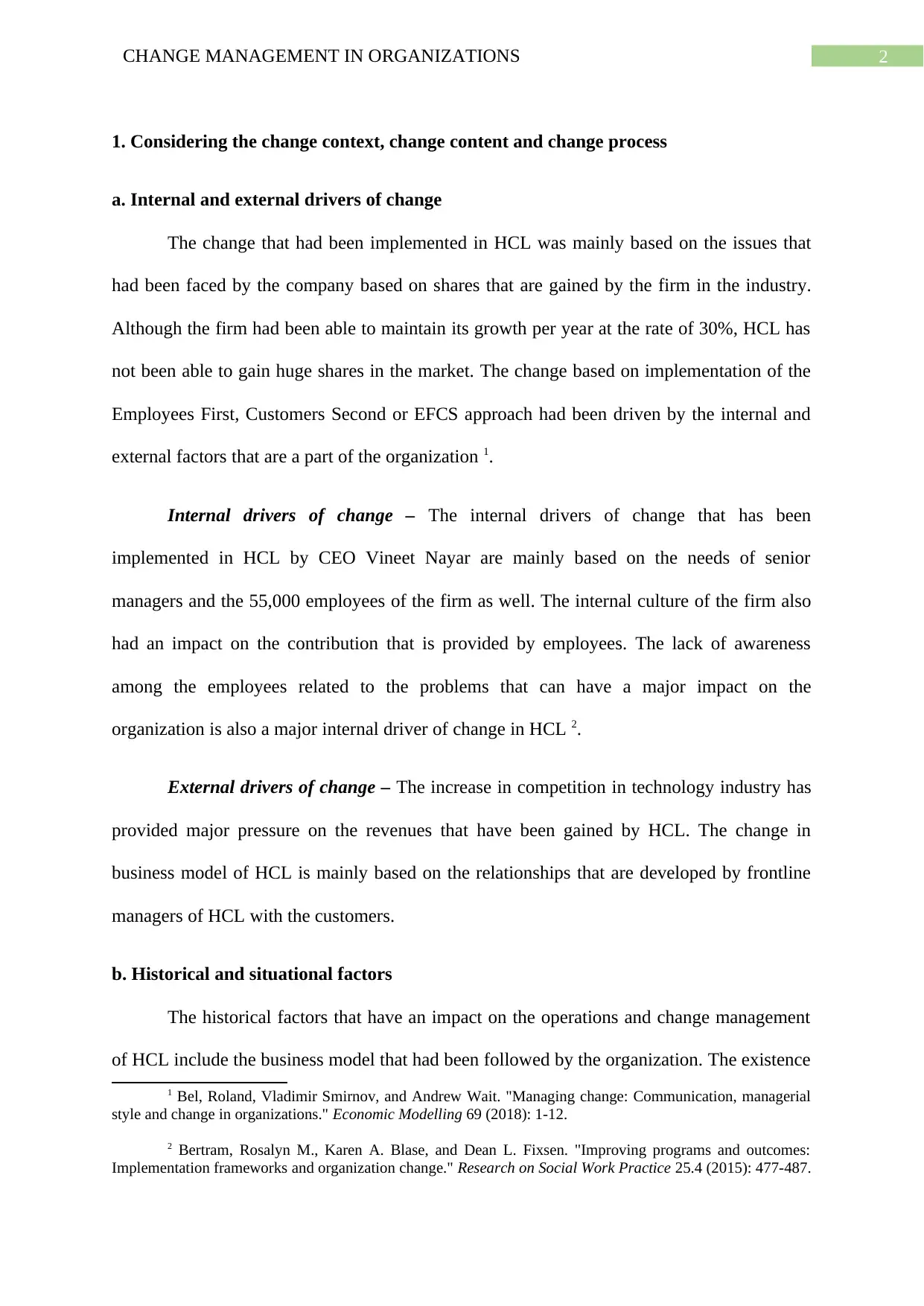
2CHANGE MANAGEMENT IN ORGANIZATIONS
1. Considering the change context, change content and change process
a. Internal and external drivers of change
The change that had been implemented in HCL was mainly based on the issues that
had been faced by the company based on shares that are gained by the firm in the industry.
Although the firm had been able to maintain its growth per year at the rate of 30%, HCL has
not been able to gain huge shares in the market. The change based on implementation of the
Employees First, Customers Second or EFCS approach had been driven by the internal and
external factors that are a part of the organization 1.
Internal drivers of change – The internal drivers of change that has been
implemented in HCL by CEO Vineet Nayar are mainly based on the needs of senior
managers and the 55,000 employees of the firm as well. The internal culture of the firm also
had an impact on the contribution that is provided by employees. The lack of awareness
among the employees related to the problems that can have a major impact on the
organization is also a major internal driver of change in HCL 2.
External drivers of change – The increase in competition in technology industry has
provided major pressure on the revenues that have been gained by HCL. The change in
business model of HCL is mainly based on the relationships that are developed by frontline
managers of HCL with the customers.
b. Historical and situational factors
The historical factors that have an impact on the operations and change management
of HCL include the business model that had been followed by the organization. The existence
1 Bel, Roland, Vladimir Smirnov, and Andrew Wait. "Managing change: Communication, managerial
style and change in organizations." Economic Modelling 69 (2018): 1-12.
2 Bertram, Rosalyn M., Karen A. Blase, and Dean L. Fixsen. "Improving programs and outcomes:
Implementation frameworks and organization change." Research on Social Work Practice 25.4 (2015): 477-487.
1. Considering the change context, change content and change process
a. Internal and external drivers of change
The change that had been implemented in HCL was mainly based on the issues that
had been faced by the company based on shares that are gained by the firm in the industry.
Although the firm had been able to maintain its growth per year at the rate of 30%, HCL has
not been able to gain huge shares in the market. The change based on implementation of the
Employees First, Customers Second or EFCS approach had been driven by the internal and
external factors that are a part of the organization 1.
Internal drivers of change – The internal drivers of change that has been
implemented in HCL by CEO Vineet Nayar are mainly based on the needs of senior
managers and the 55,000 employees of the firm as well. The internal culture of the firm also
had an impact on the contribution that is provided by employees. The lack of awareness
among the employees related to the problems that can have a major impact on the
organization is also a major internal driver of change in HCL 2.
External drivers of change – The increase in competition in technology industry has
provided major pressure on the revenues that have been gained by HCL. The change in
business model of HCL is mainly based on the relationships that are developed by frontline
managers of HCL with the customers.
b. Historical and situational factors
The historical factors that have an impact on the operations and change management
of HCL include the business model that had been followed by the organization. The existence
1 Bel, Roland, Vladimir Smirnov, and Andrew Wait. "Managing change: Communication, managerial
style and change in organizations." Economic Modelling 69 (2018): 1-12.
2 Bertram, Rosalyn M., Karen A. Blase, and Dean L. Fixsen. "Improving programs and outcomes:
Implementation frameworks and organization change." Research on Social Work Practice 25.4 (2015): 477-487.
⊘ This is a preview!⊘
Do you want full access?
Subscribe today to unlock all pages.

Trusted by 1+ million students worldwide
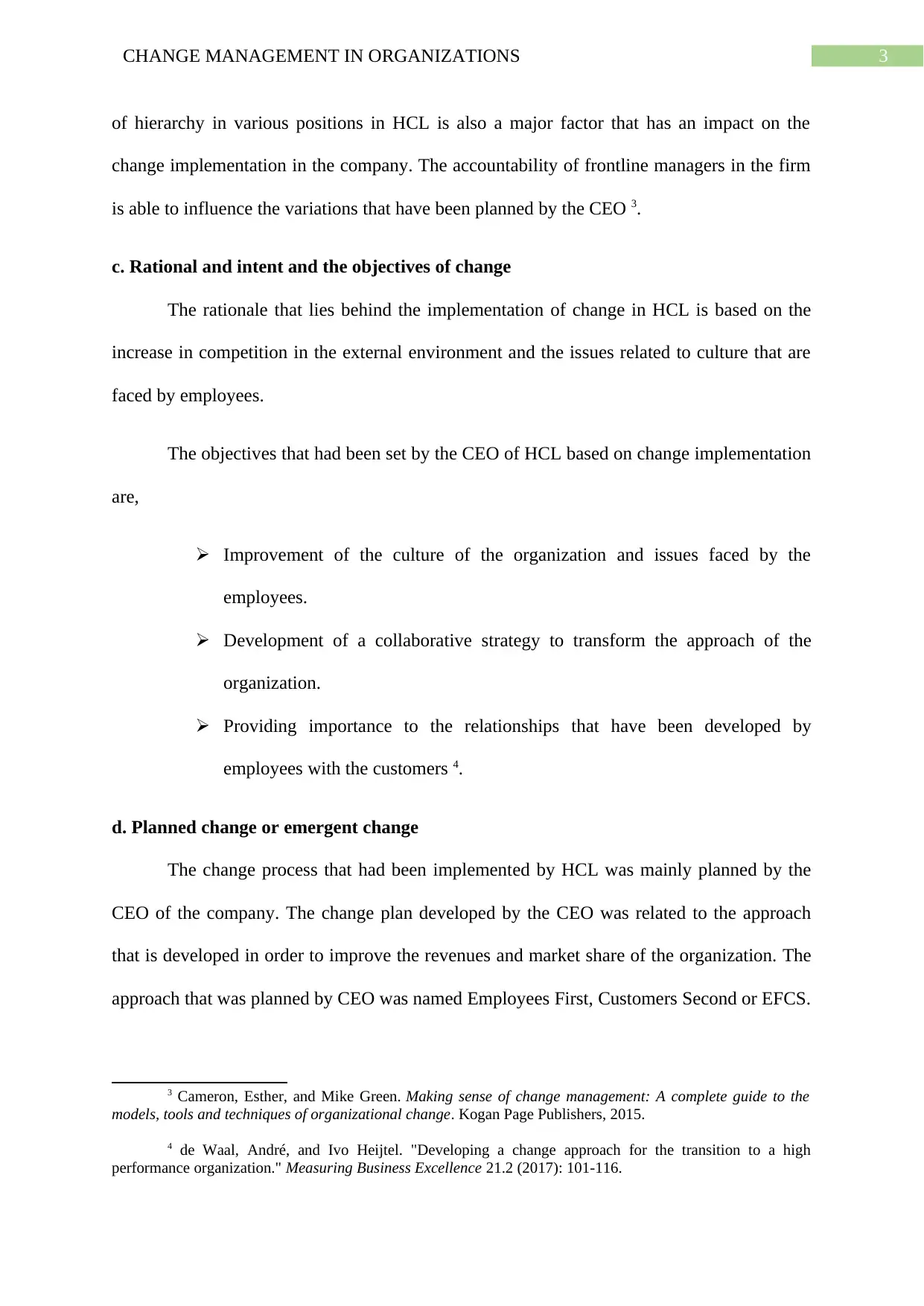
3CHANGE MANAGEMENT IN ORGANIZATIONS
of hierarchy in various positions in HCL is also a major factor that has an impact on the
change implementation in the company. The accountability of frontline managers in the firm
is able to influence the variations that have been planned by the CEO 3.
c. Rational and intent and the objectives of change
The rationale that lies behind the implementation of change in HCL is based on the
increase in competition in the external environment and the issues related to culture that are
faced by employees.
The objectives that had been set by the CEO of HCL based on change implementation
are,
Improvement of the culture of the organization and issues faced by the
employees.
Development of a collaborative strategy to transform the approach of the
organization.
Providing importance to the relationships that have been developed by
employees with the customers 4.
d. Planned change or emergent change
The change process that had been implemented by HCL was mainly planned by the
CEO of the company. The change plan developed by the CEO was related to the approach
that is developed in order to improve the revenues and market share of the organization. The
approach that was planned by CEO was named Employees First, Customers Second or EFCS.
3 Cameron, Esther, and Mike Green. Making sense of change management: A complete guide to the
models, tools and techniques of organizational change. Kogan Page Publishers, 2015.
4 de Waal, André, and Ivo Heijtel. "Developing a change approach for the transition to a high
performance organization." Measuring Business Excellence 21.2 (2017): 101-116.
of hierarchy in various positions in HCL is also a major factor that has an impact on the
change implementation in the company. The accountability of frontline managers in the firm
is able to influence the variations that have been planned by the CEO 3.
c. Rational and intent and the objectives of change
The rationale that lies behind the implementation of change in HCL is based on the
increase in competition in the external environment and the issues related to culture that are
faced by employees.
The objectives that had been set by the CEO of HCL based on change implementation
are,
Improvement of the culture of the organization and issues faced by the
employees.
Development of a collaborative strategy to transform the approach of the
organization.
Providing importance to the relationships that have been developed by
employees with the customers 4.
d. Planned change or emergent change
The change process that had been implemented by HCL was mainly planned by the
CEO of the company. The change plan developed by the CEO was related to the approach
that is developed in order to improve the revenues and market share of the organization. The
approach that was planned by CEO was named Employees First, Customers Second or EFCS.
3 Cameron, Esther, and Mike Green. Making sense of change management: A complete guide to the
models, tools and techniques of organizational change. Kogan Page Publishers, 2015.
4 de Waal, André, and Ivo Heijtel. "Developing a change approach for the transition to a high
performance organization." Measuring Business Excellence 21.2 (2017): 101-116.
Paraphrase This Document
Need a fresh take? Get an instant paraphrase of this document with our AI Paraphraser
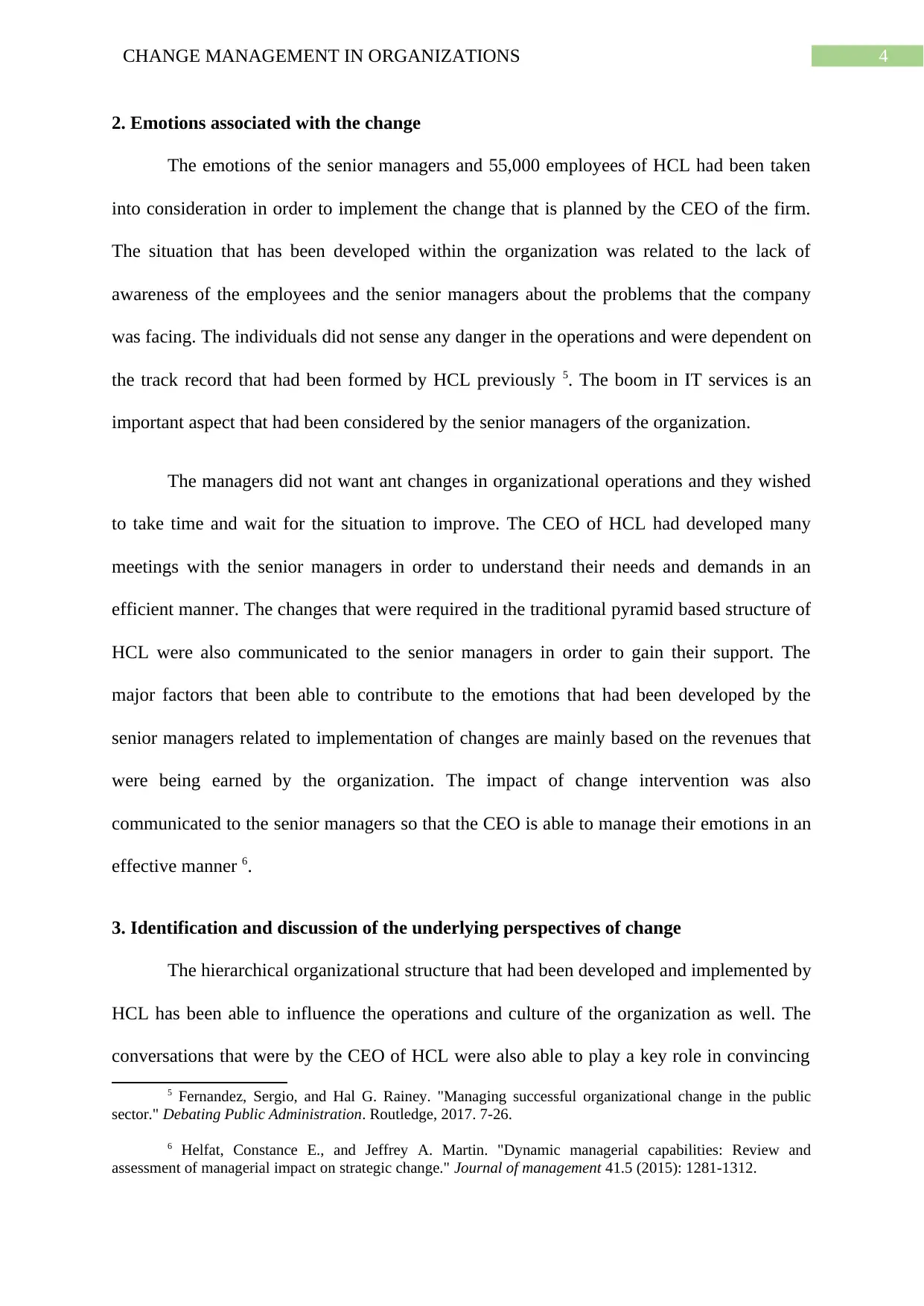
4CHANGE MANAGEMENT IN ORGANIZATIONS
2. Emotions associated with the change
The emotions of the senior managers and 55,000 employees of HCL had been taken
into consideration in order to implement the change that is planned by the CEO of the firm.
The situation that has been developed within the organization was related to the lack of
awareness of the employees and the senior managers about the problems that the company
was facing. The individuals did not sense any danger in the operations and were dependent on
the track record that had been formed by HCL previously 5. The boom in IT services is an
important aspect that had been considered by the senior managers of the organization.
The managers did not want ant changes in organizational operations and they wished
to take time and wait for the situation to improve. The CEO of HCL had developed many
meetings with the senior managers in order to understand their needs and demands in an
efficient manner. The changes that were required in the traditional pyramid based structure of
HCL were also communicated to the senior managers in order to gain their support. The
major factors that been able to contribute to the emotions that had been developed by the
senior managers related to implementation of changes are mainly based on the revenues that
were being earned by the organization. The impact of change intervention was also
communicated to the senior managers so that the CEO is able to manage their emotions in an
effective manner 6.
3. Identification and discussion of the underlying perspectives of change
The hierarchical organizational structure that had been developed and implemented by
HCL has been able to influence the operations and culture of the organization as well. The
conversations that were by the CEO of HCL were also able to play a key role in convincing
5 Fernandez, Sergio, and Hal G. Rainey. "Managing successful organizational change in the public
sector." Debating Public Administration. Routledge, 2017. 7-26.
6 Helfat, Constance E., and Jeffrey A. Martin. "Dynamic managerial capabilities: Review and
assessment of managerial impact on strategic change." Journal of management 41.5 (2015): 1281-1312.
2. Emotions associated with the change
The emotions of the senior managers and 55,000 employees of HCL had been taken
into consideration in order to implement the change that is planned by the CEO of the firm.
The situation that has been developed within the organization was related to the lack of
awareness of the employees and the senior managers about the problems that the company
was facing. The individuals did not sense any danger in the operations and were dependent on
the track record that had been formed by HCL previously 5. The boom in IT services is an
important aspect that had been considered by the senior managers of the organization.
The managers did not want ant changes in organizational operations and they wished
to take time and wait for the situation to improve. The CEO of HCL had developed many
meetings with the senior managers in order to understand their needs and demands in an
efficient manner. The changes that were required in the traditional pyramid based structure of
HCL were also communicated to the senior managers in order to gain their support. The
major factors that been able to contribute to the emotions that had been developed by the
senior managers related to implementation of changes are mainly based on the revenues that
were being earned by the organization. The impact of change intervention was also
communicated to the senior managers so that the CEO is able to manage their emotions in an
effective manner 6.
3. Identification and discussion of the underlying perspectives of change
The hierarchical organizational structure that had been developed and implemented by
HCL has been able to influence the operations and culture of the organization as well. The
conversations that were by the CEO of HCL were also able to play a key role in convincing
5 Fernandez, Sergio, and Hal G. Rainey. "Managing successful organizational change in the public
sector." Debating Public Administration. Routledge, 2017. 7-26.
6 Helfat, Constance E., and Jeffrey A. Martin. "Dynamic managerial capabilities: Review and
assessment of managerial impact on strategic change." Journal of management 41.5 (2015): 1281-1312.
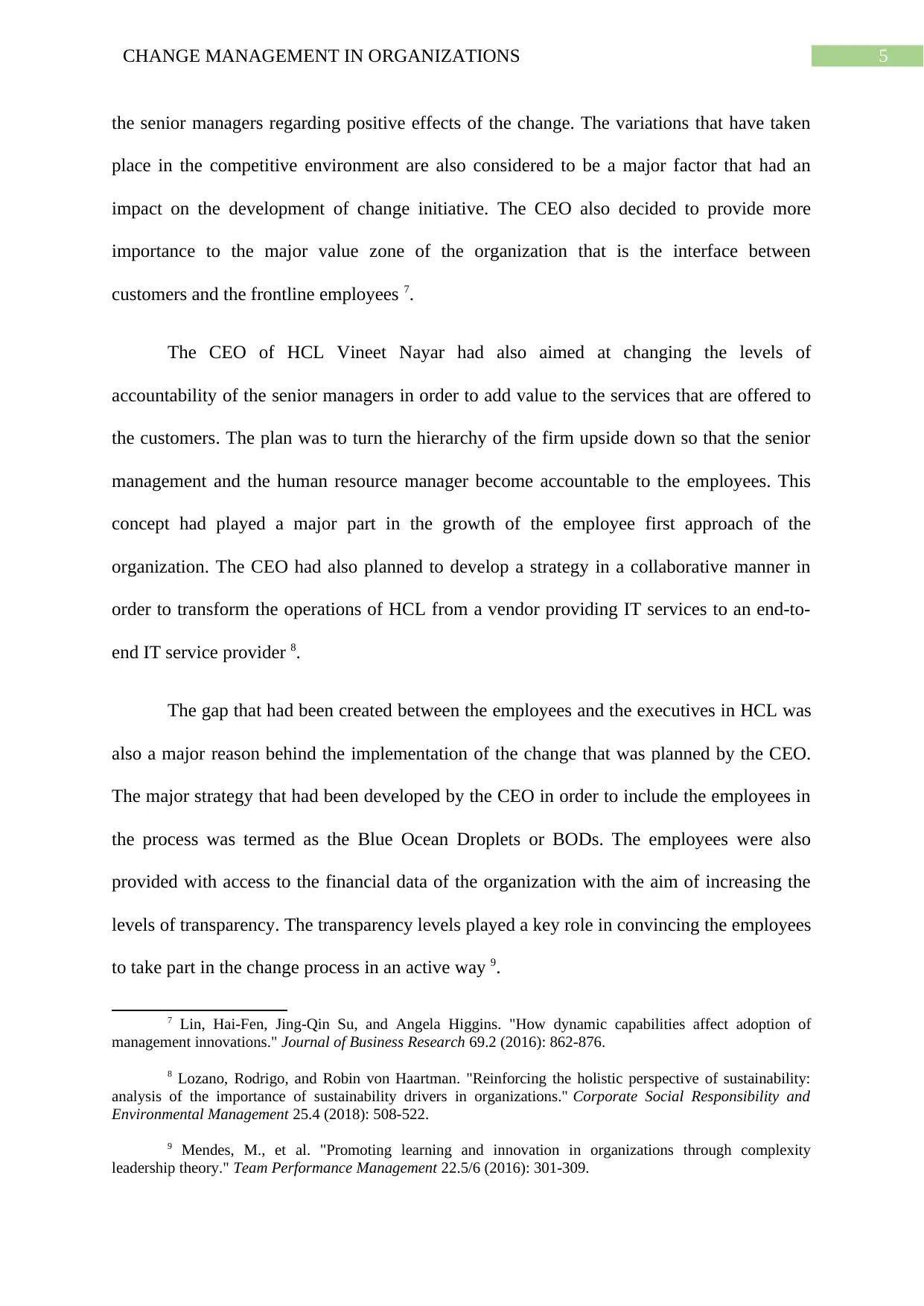
5CHANGE MANAGEMENT IN ORGANIZATIONS
the senior managers regarding positive effects of the change. The variations that have taken
place in the competitive environment are also considered to be a major factor that had an
impact on the development of change initiative. The CEO also decided to provide more
importance to the major value zone of the organization that is the interface between
customers and the frontline employees 7.
The CEO of HCL Vineet Nayar had also aimed at changing the levels of
accountability of the senior managers in order to add value to the services that are offered to
the customers. The plan was to turn the hierarchy of the firm upside down so that the senior
management and the human resource manager become accountable to the employees. This
concept had played a major part in the growth of the employee first approach of the
organization. The CEO had also planned to develop a strategy in a collaborative manner in
order to transform the operations of HCL from a vendor providing IT services to an end-to-
end IT service provider 8.
The gap that had been created between the employees and the executives in HCL was
also a major reason behind the implementation of the change that was planned by the CEO.
The major strategy that had been developed by the CEO in order to include the employees in
the process was termed as the Blue Ocean Droplets or BODs. The employees were also
provided with access to the financial data of the organization with the aim of increasing the
levels of transparency. The transparency levels played a key role in convincing the employees
to take part in the change process in an active way 9.
7 Lin, Hai-Fen, Jing-Qin Su, and Angela Higgins. "How dynamic capabilities affect adoption of
management innovations." Journal of Business Research 69.2 (2016): 862-876.
8 Lozano, Rodrigo, and Robin von Haartman. "Reinforcing the holistic perspective of sustainability:
analysis of the importance of sustainability drivers in organizations." Corporate Social Responsibility and
Environmental Management 25.4 (2018): 508-522.
9 Mendes, M., et al. "Promoting learning and innovation in organizations through complexity
leadership theory." Team Performance Management 22.5/6 (2016): 301-309.
the senior managers regarding positive effects of the change. The variations that have taken
place in the competitive environment are also considered to be a major factor that had an
impact on the development of change initiative. The CEO also decided to provide more
importance to the major value zone of the organization that is the interface between
customers and the frontline employees 7.
The CEO of HCL Vineet Nayar had also aimed at changing the levels of
accountability of the senior managers in order to add value to the services that are offered to
the customers. The plan was to turn the hierarchy of the firm upside down so that the senior
management and the human resource manager become accountable to the employees. This
concept had played a major part in the growth of the employee first approach of the
organization. The CEO had also planned to develop a strategy in a collaborative manner in
order to transform the operations of HCL from a vendor providing IT services to an end-to-
end IT service provider 8.
The gap that had been created between the employees and the executives in HCL was
also a major reason behind the implementation of the change that was planned by the CEO.
The major strategy that had been developed by the CEO in order to include the employees in
the process was termed as the Blue Ocean Droplets or BODs. The employees were also
provided with access to the financial data of the organization with the aim of increasing the
levels of transparency. The transparency levels played a key role in convincing the employees
to take part in the change process in an active way 9.
7 Lin, Hai-Fen, Jing-Qin Su, and Angela Higgins. "How dynamic capabilities affect adoption of
management innovations." Journal of Business Research 69.2 (2016): 862-876.
8 Lozano, Rodrigo, and Robin von Haartman. "Reinforcing the holistic perspective of sustainability:
analysis of the importance of sustainability drivers in organizations." Corporate Social Responsibility and
Environmental Management 25.4 (2018): 508-522.
9 Mendes, M., et al. "Promoting learning and innovation in organizations through complexity
leadership theory." Team Performance Management 22.5/6 (2016): 301-309.
⊘ This is a preview!⊘
Do you want full access?
Subscribe today to unlock all pages.

Trusted by 1+ million students worldwide
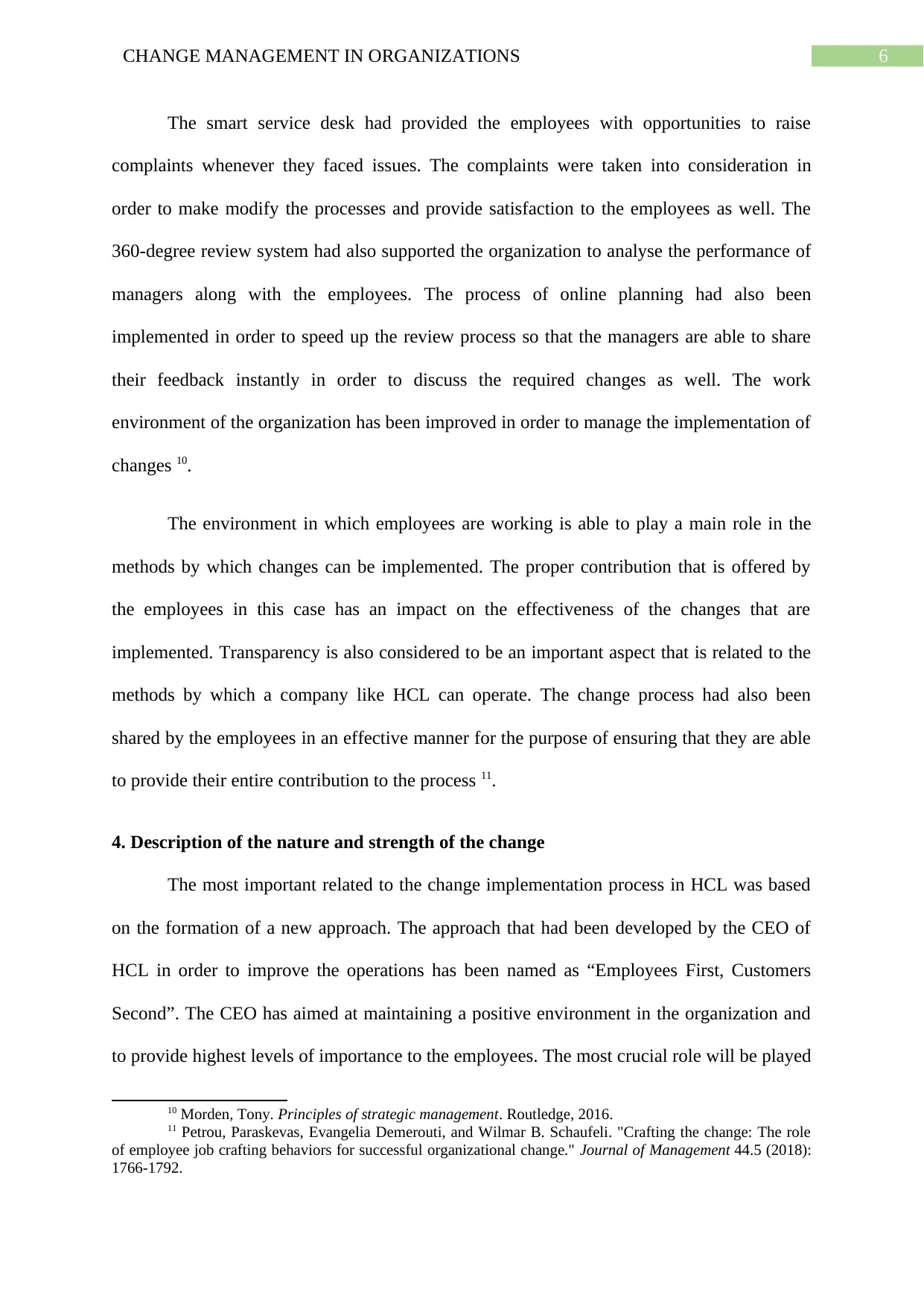
6CHANGE MANAGEMENT IN ORGANIZATIONS
The smart service desk had provided the employees with opportunities to raise
complaints whenever they faced issues. The complaints were taken into consideration in
order to make modify the processes and provide satisfaction to the employees as well. The
360-degree review system had also supported the organization to analyse the performance of
managers along with the employees. The process of online planning had also been
implemented in order to speed up the review process so that the managers are able to share
their feedback instantly in order to discuss the required changes as well. The work
environment of the organization has been improved in order to manage the implementation of
changes 10.
The environment in which employees are working is able to play a main role in the
methods by which changes can be implemented. The proper contribution that is offered by
the employees in this case has an impact on the effectiveness of the changes that are
implemented. Transparency is also considered to be an important aspect that is related to the
methods by which a company like HCL can operate. The change process had also been
shared by the employees in an effective manner for the purpose of ensuring that they are able
to provide their entire contribution to the process 11.
4. Description of the nature and strength of the change
The most important related to the change implementation process in HCL was based
on the formation of a new approach. The approach that had been developed by the CEO of
HCL in order to improve the operations has been named as “Employees First, Customers
Second”. The CEO has aimed at maintaining a positive environment in the organization and
to provide highest levels of importance to the employees. The most crucial role will be played
10 Morden, Tony. Principles of strategic management. Routledge, 2016.
11 Petrou, Paraskevas, Evangelia Demerouti, and Wilmar B. Schaufeli. "Crafting the change: The role
of employee job crafting behaviors for successful organizational change." Journal of Management 44.5 (2018):
1766-1792.
The smart service desk had provided the employees with opportunities to raise
complaints whenever they faced issues. The complaints were taken into consideration in
order to make modify the processes and provide satisfaction to the employees as well. The
360-degree review system had also supported the organization to analyse the performance of
managers along with the employees. The process of online planning had also been
implemented in order to speed up the review process so that the managers are able to share
their feedback instantly in order to discuss the required changes as well. The work
environment of the organization has been improved in order to manage the implementation of
changes 10.
The environment in which employees are working is able to play a main role in the
methods by which changes can be implemented. The proper contribution that is offered by
the employees in this case has an impact on the effectiveness of the changes that are
implemented. Transparency is also considered to be an important aspect that is related to the
methods by which a company like HCL can operate. The change process had also been
shared by the employees in an effective manner for the purpose of ensuring that they are able
to provide their entire contribution to the process 11.
4. Description of the nature and strength of the change
The most important related to the change implementation process in HCL was based
on the formation of a new approach. The approach that had been developed by the CEO of
HCL in order to improve the operations has been named as “Employees First, Customers
Second”. The CEO has aimed at maintaining a positive environment in the organization and
to provide highest levels of importance to the employees. The most crucial role will be played
10 Morden, Tony. Principles of strategic management. Routledge, 2016.
11 Petrou, Paraskevas, Evangelia Demerouti, and Wilmar B. Schaufeli. "Crafting the change: The role
of employee job crafting behaviors for successful organizational change." Journal of Management 44.5 (2018):
1766-1792.
Paraphrase This Document
Need a fresh take? Get an instant paraphrase of this document with our AI Paraphraser
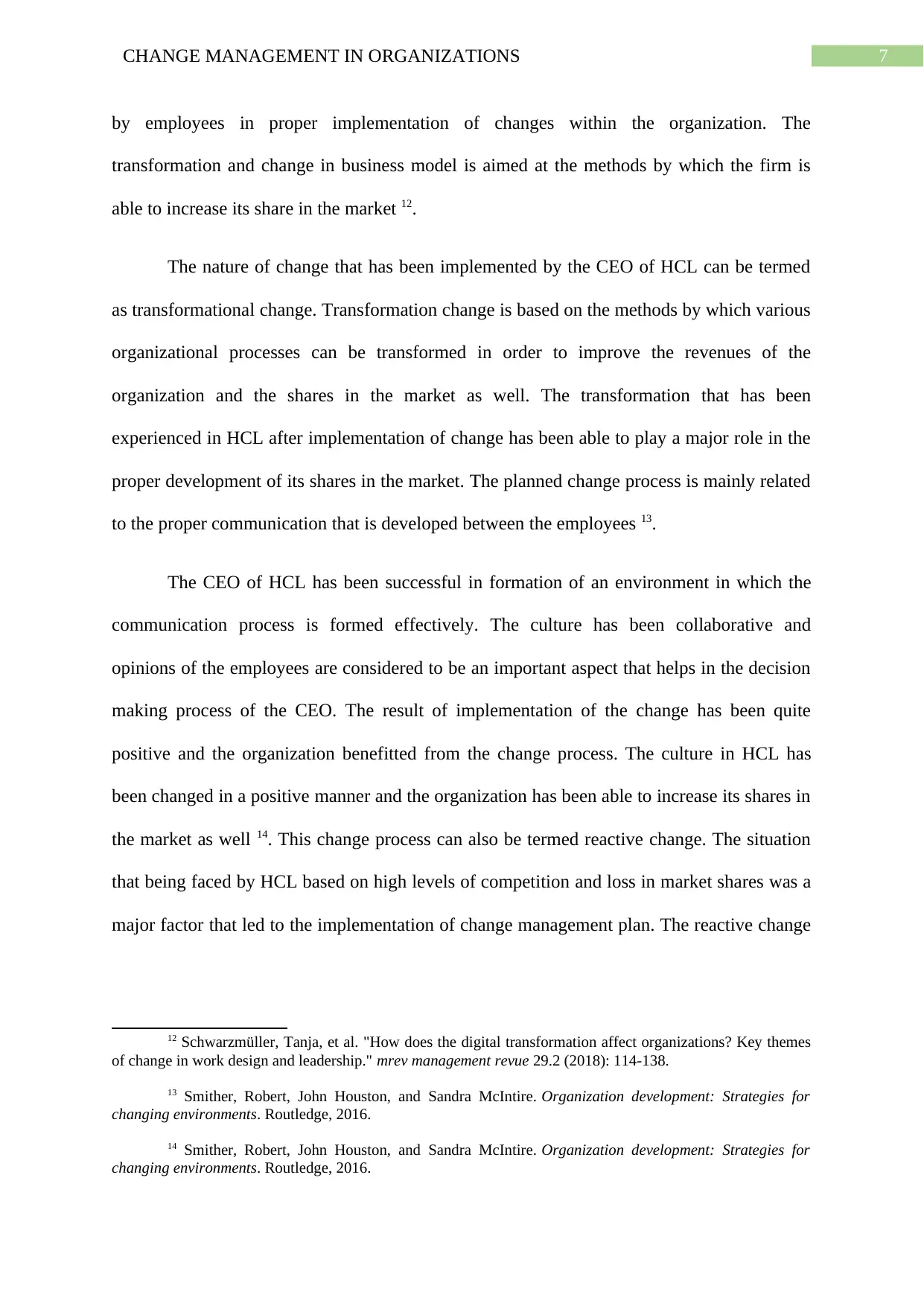
7CHANGE MANAGEMENT IN ORGANIZATIONS
by employees in proper implementation of changes within the organization. The
transformation and change in business model is aimed at the methods by which the firm is
able to increase its share in the market 12.
The nature of change that has been implemented by the CEO of HCL can be termed
as transformational change. Transformation change is based on the methods by which various
organizational processes can be transformed in order to improve the revenues of the
organization and the shares in the market as well. The transformation that has been
experienced in HCL after implementation of change has been able to play a major role in the
proper development of its shares in the market. The planned change process is mainly related
to the proper communication that is developed between the employees 13.
The CEO of HCL has been successful in formation of an environment in which the
communication process is formed effectively. The culture has been collaborative and
opinions of the employees are considered to be an important aspect that helps in the decision
making process of the CEO. The result of implementation of the change has been quite
positive and the organization benefitted from the change process. The culture in HCL has
been changed in a positive manner and the organization has been able to increase its shares in
the market as well 14. This change process can also be termed reactive change. The situation
that being faced by HCL based on high levels of competition and loss in market shares was a
major factor that led to the implementation of change management plan. The reactive change
12 Schwarzmüller, Tanja, et al. "How does the digital transformation affect organizations? Key themes
of change in work design and leadership." mrev management revue 29.2 (2018): 114-138.
13 Smither, Robert, John Houston, and Sandra McIntire. Organization development: Strategies for
changing environments. Routledge, 2016.
14 Smither, Robert, John Houston, and Sandra McIntire. Organization development: Strategies for
changing environments. Routledge, 2016.
by employees in proper implementation of changes within the organization. The
transformation and change in business model is aimed at the methods by which the firm is
able to increase its share in the market 12.
The nature of change that has been implemented by the CEO of HCL can be termed
as transformational change. Transformation change is based on the methods by which various
organizational processes can be transformed in order to improve the revenues of the
organization and the shares in the market as well. The transformation that has been
experienced in HCL after implementation of change has been able to play a major role in the
proper development of its shares in the market. The planned change process is mainly related
to the proper communication that is developed between the employees 13.
The CEO of HCL has been successful in formation of an environment in which the
communication process is formed effectively. The culture has been collaborative and
opinions of the employees are considered to be an important aspect that helps in the decision
making process of the CEO. The result of implementation of the change has been quite
positive and the organization benefitted from the change process. The culture in HCL has
been changed in a positive manner and the organization has been able to increase its shares in
the market as well 14. This change process can also be termed reactive change. The situation
that being faced by HCL based on high levels of competition and loss in market shares was a
major factor that led to the implementation of change management plan. The reactive change
12 Schwarzmüller, Tanja, et al. "How does the digital transformation affect organizations? Key themes
of change in work design and leadership." mrev management revue 29.2 (2018): 114-138.
13 Smither, Robert, John Houston, and Sandra McIntire. Organization development: Strategies for
changing environments. Routledge, 2016.
14 Smither, Robert, John Houston, and Sandra McIntire. Organization development: Strategies for
changing environments. Routledge, 2016.
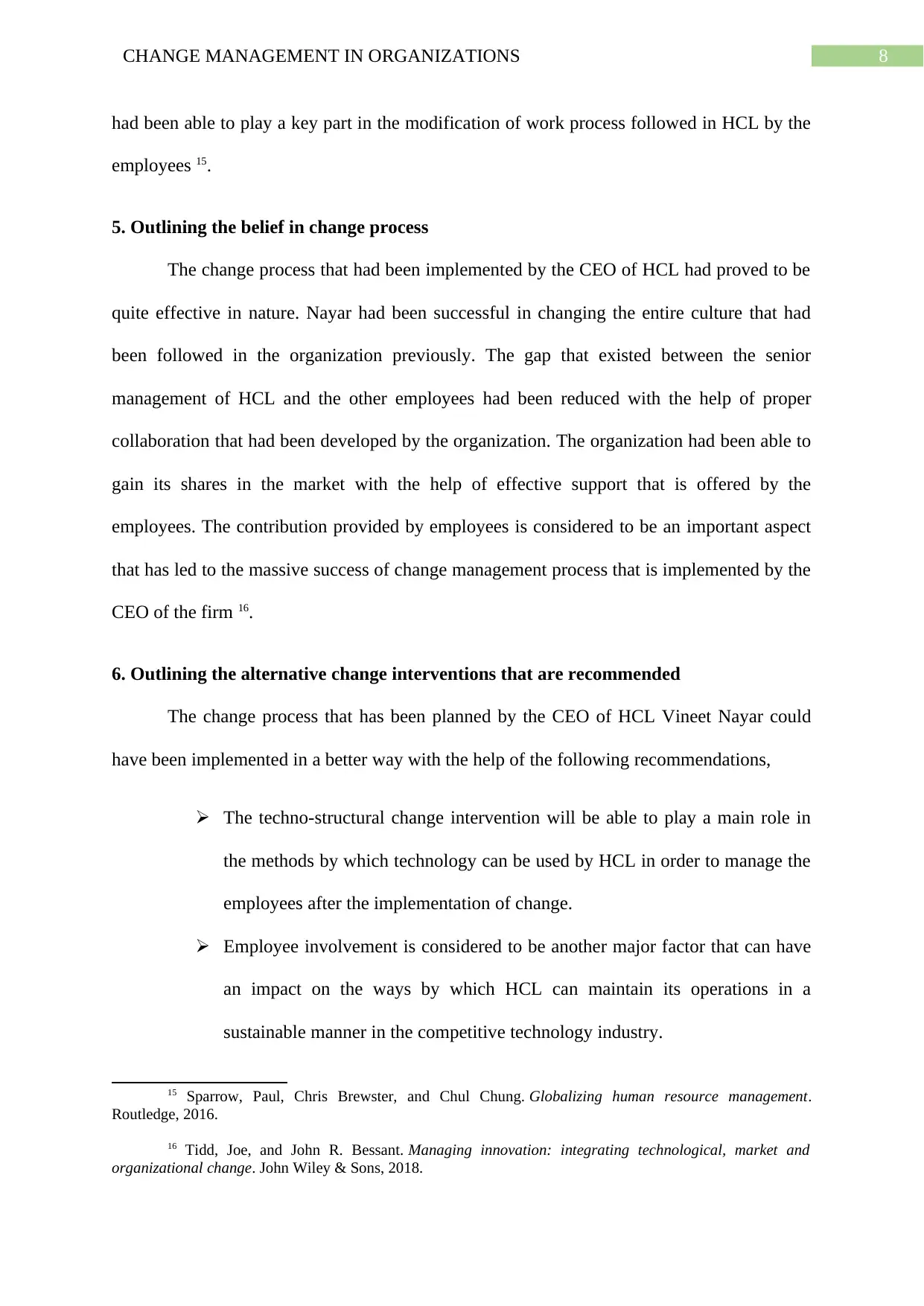
8CHANGE MANAGEMENT IN ORGANIZATIONS
had been able to play a key part in the modification of work process followed in HCL by the
employees 15.
5. Outlining the belief in change process
The change process that had been implemented by the CEO of HCL had proved to be
quite effective in nature. Nayar had been successful in changing the entire culture that had
been followed in the organization previously. The gap that existed between the senior
management of HCL and the other employees had been reduced with the help of proper
collaboration that had been developed by the organization. The organization had been able to
gain its shares in the market with the help of effective support that is offered by the
employees. The contribution provided by employees is considered to be an important aspect
that has led to the massive success of change management process that is implemented by the
CEO of the firm 16.
6. Outlining the alternative change interventions that are recommended
The change process that has been planned by the CEO of HCL Vineet Nayar could
have been implemented in a better way with the help of the following recommendations,
The techno-structural change intervention will be able to play a main role in
the methods by which technology can be used by HCL in order to manage the
employees after the implementation of change.
Employee involvement is considered to be another major factor that can have
an impact on the ways by which HCL can maintain its operations in a
sustainable manner in the competitive technology industry.
15 Sparrow, Paul, Chris Brewster, and Chul Chung. Globalizing human resource management.
Routledge, 2016.
16 Tidd, Joe, and John R. Bessant. Managing innovation: integrating technological, market and
organizational change. John Wiley & Sons, 2018.
had been able to play a key part in the modification of work process followed in HCL by the
employees 15.
5. Outlining the belief in change process
The change process that had been implemented by the CEO of HCL had proved to be
quite effective in nature. Nayar had been successful in changing the entire culture that had
been followed in the organization previously. The gap that existed between the senior
management of HCL and the other employees had been reduced with the help of proper
collaboration that had been developed by the organization. The organization had been able to
gain its shares in the market with the help of effective support that is offered by the
employees. The contribution provided by employees is considered to be an important aspect
that has led to the massive success of change management process that is implemented by the
CEO of the firm 16.
6. Outlining the alternative change interventions that are recommended
The change process that has been planned by the CEO of HCL Vineet Nayar could
have been implemented in a better way with the help of the following recommendations,
The techno-structural change intervention will be able to play a main role in
the methods by which technology can be used by HCL in order to manage the
employees after the implementation of change.
Employee involvement is considered to be another major factor that can have
an impact on the ways by which HCL can maintain its operations in a
sustainable manner in the competitive technology industry.
15 Sparrow, Paul, Chris Brewster, and Chul Chung. Globalizing human resource management.
Routledge, 2016.
16 Tidd, Joe, and John R. Bessant. Managing innovation: integrating technological, market and
organizational change. John Wiley & Sons, 2018.
⊘ This is a preview!⊘
Do you want full access?
Subscribe today to unlock all pages.

Trusted by 1+ million students worldwide
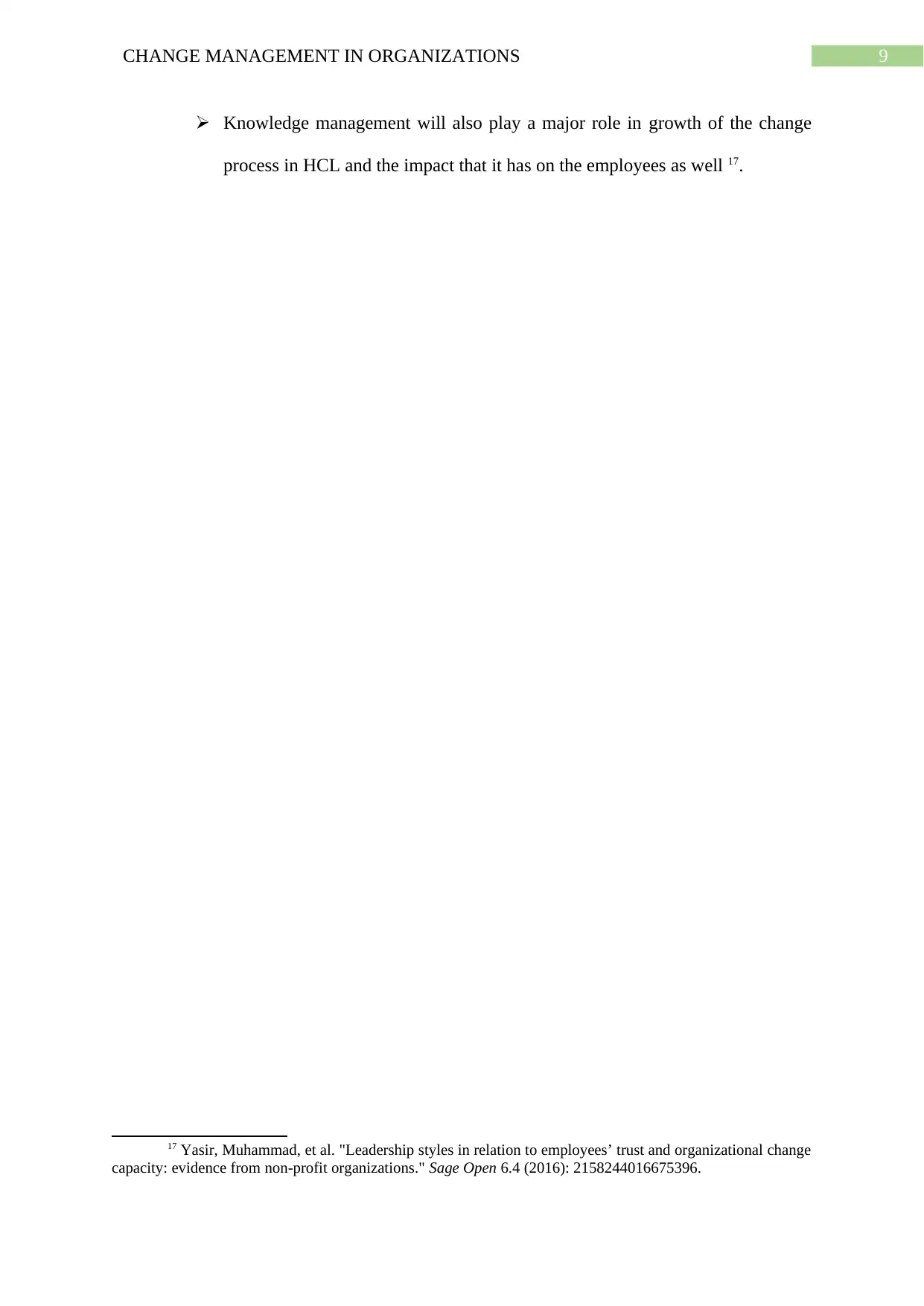
9CHANGE MANAGEMENT IN ORGANIZATIONS
Knowledge management will also play a major role in growth of the change
process in HCL and the impact that it has on the employees as well 17.
17 Yasir, Muhammad, et al. "Leadership styles in relation to employees’ trust and organizational change
capacity: evidence from non-profit organizations." Sage Open 6.4 (2016): 2158244016675396.
Knowledge management will also play a major role in growth of the change
process in HCL and the impact that it has on the employees as well 17.
17 Yasir, Muhammad, et al. "Leadership styles in relation to employees’ trust and organizational change
capacity: evidence from non-profit organizations." Sage Open 6.4 (2016): 2158244016675396.
Paraphrase This Document
Need a fresh take? Get an instant paraphrase of this document with our AI Paraphraser
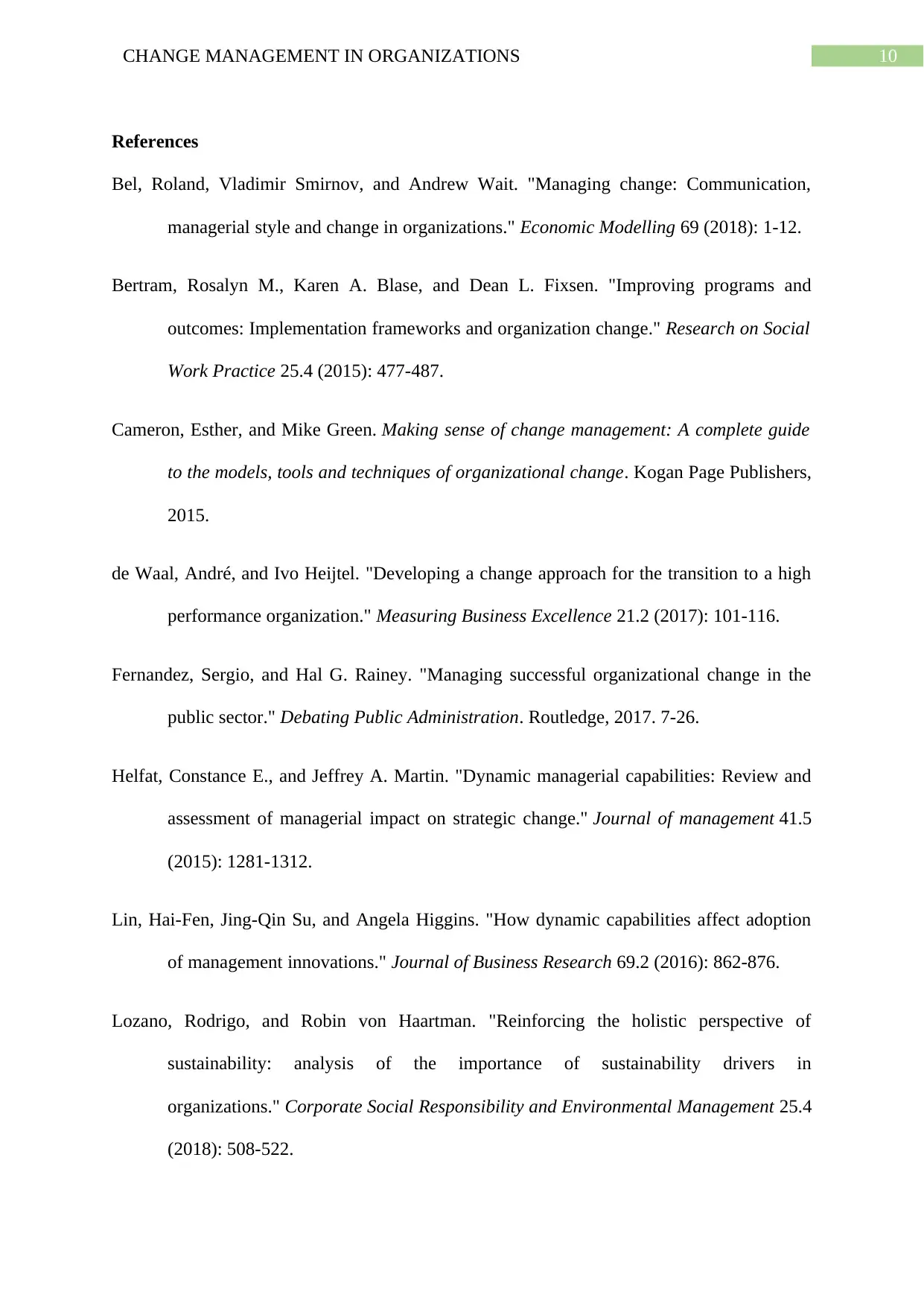
10CHANGE MANAGEMENT IN ORGANIZATIONS
References
Bel, Roland, Vladimir Smirnov, and Andrew Wait. "Managing change: Communication,
managerial style and change in organizations." Economic Modelling 69 (2018): 1-12.
Bertram, Rosalyn M., Karen A. Blase, and Dean L. Fixsen. "Improving programs and
outcomes: Implementation frameworks and organization change." Research on Social
Work Practice 25.4 (2015): 477-487.
Cameron, Esther, and Mike Green. Making sense of change management: A complete guide
to the models, tools and techniques of organizational change. Kogan Page Publishers,
2015.
de Waal, André, and Ivo Heijtel. "Developing a change approach for the transition to a high
performance organization." Measuring Business Excellence 21.2 (2017): 101-116.
Fernandez, Sergio, and Hal G. Rainey. "Managing successful organizational change in the
public sector." Debating Public Administration. Routledge, 2017. 7-26.
Helfat, Constance E., and Jeffrey A. Martin. "Dynamic managerial capabilities: Review and
assessment of managerial impact on strategic change." Journal of management 41.5
(2015): 1281-1312.
Lin, Hai-Fen, Jing-Qin Su, and Angela Higgins. "How dynamic capabilities affect adoption
of management innovations." Journal of Business Research 69.2 (2016): 862-876.
Lozano, Rodrigo, and Robin von Haartman. "Reinforcing the holistic perspective of
sustainability: analysis of the importance of sustainability drivers in
organizations." Corporate Social Responsibility and Environmental Management 25.4
(2018): 508-522.
References
Bel, Roland, Vladimir Smirnov, and Andrew Wait. "Managing change: Communication,
managerial style and change in organizations." Economic Modelling 69 (2018): 1-12.
Bertram, Rosalyn M., Karen A. Blase, and Dean L. Fixsen. "Improving programs and
outcomes: Implementation frameworks and organization change." Research on Social
Work Practice 25.4 (2015): 477-487.
Cameron, Esther, and Mike Green. Making sense of change management: A complete guide
to the models, tools and techniques of organizational change. Kogan Page Publishers,
2015.
de Waal, André, and Ivo Heijtel. "Developing a change approach for the transition to a high
performance organization." Measuring Business Excellence 21.2 (2017): 101-116.
Fernandez, Sergio, and Hal G. Rainey. "Managing successful organizational change in the
public sector." Debating Public Administration. Routledge, 2017. 7-26.
Helfat, Constance E., and Jeffrey A. Martin. "Dynamic managerial capabilities: Review and
assessment of managerial impact on strategic change." Journal of management 41.5
(2015): 1281-1312.
Lin, Hai-Fen, Jing-Qin Su, and Angela Higgins. "How dynamic capabilities affect adoption
of management innovations." Journal of Business Research 69.2 (2016): 862-876.
Lozano, Rodrigo, and Robin von Haartman. "Reinforcing the holistic perspective of
sustainability: analysis of the importance of sustainability drivers in
organizations." Corporate Social Responsibility and Environmental Management 25.4
(2018): 508-522.
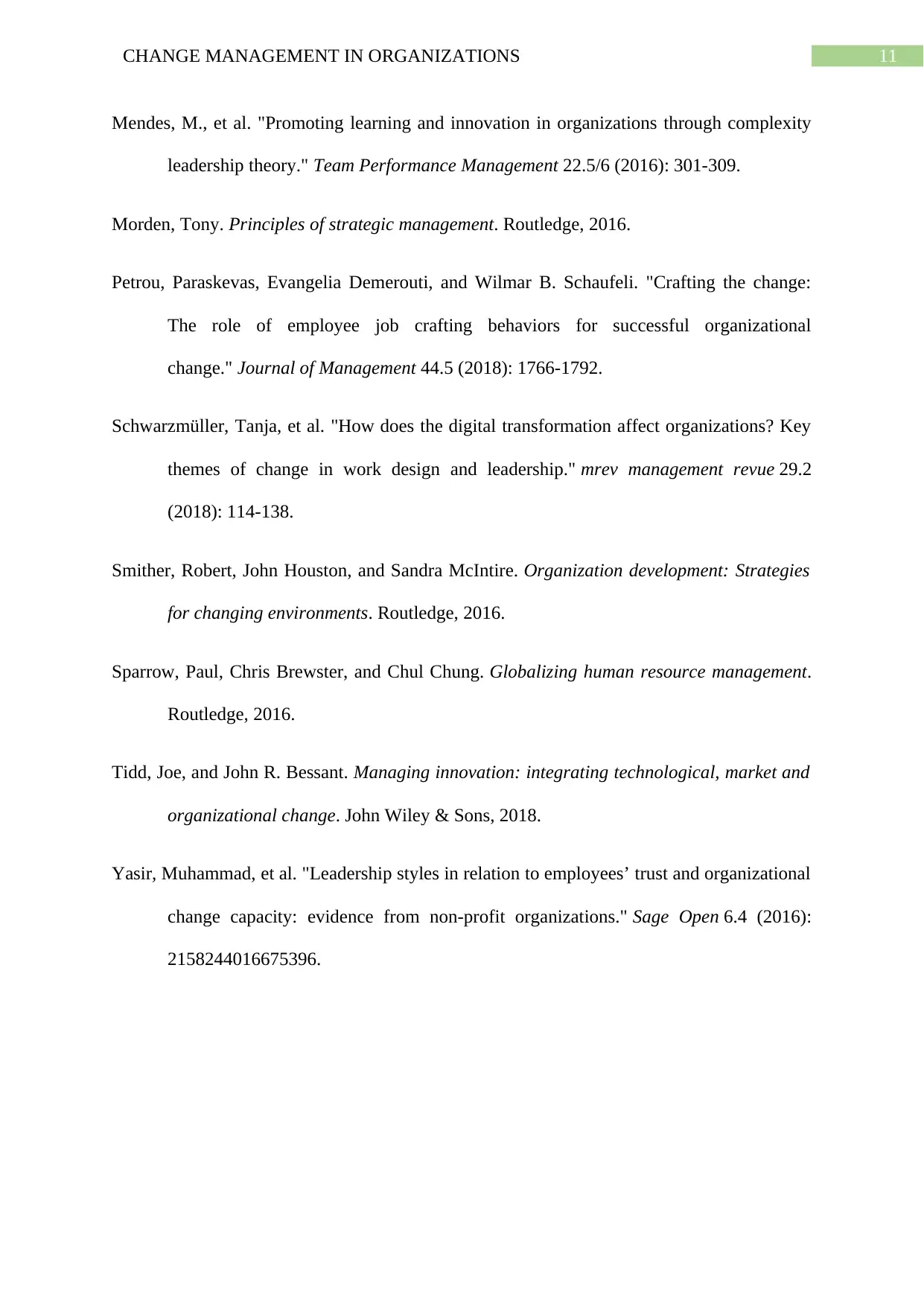
11CHANGE MANAGEMENT IN ORGANIZATIONS
Mendes, M., et al. "Promoting learning and innovation in organizations through complexity
leadership theory." Team Performance Management 22.5/6 (2016): 301-309.
Morden, Tony. Principles of strategic management. Routledge, 2016.
Petrou, Paraskevas, Evangelia Demerouti, and Wilmar B. Schaufeli. "Crafting the change:
The role of employee job crafting behaviors for successful organizational
change." Journal of Management 44.5 (2018): 1766-1792.
Schwarzmüller, Tanja, et al. "How does the digital transformation affect organizations? Key
themes of change in work design and leadership." mrev management revue 29.2
(2018): 114-138.
Smither, Robert, John Houston, and Sandra McIntire. Organization development: Strategies
for changing environments. Routledge, 2016.
Sparrow, Paul, Chris Brewster, and Chul Chung. Globalizing human resource management.
Routledge, 2016.
Tidd, Joe, and John R. Bessant. Managing innovation: integrating technological, market and
organizational change. John Wiley & Sons, 2018.
Yasir, Muhammad, et al. "Leadership styles in relation to employees’ trust and organizational
change capacity: evidence from non-profit organizations." Sage Open 6.4 (2016):
2158244016675396.
Mendes, M., et al. "Promoting learning and innovation in organizations through complexity
leadership theory." Team Performance Management 22.5/6 (2016): 301-309.
Morden, Tony. Principles of strategic management. Routledge, 2016.
Petrou, Paraskevas, Evangelia Demerouti, and Wilmar B. Schaufeli. "Crafting the change:
The role of employee job crafting behaviors for successful organizational
change." Journal of Management 44.5 (2018): 1766-1792.
Schwarzmüller, Tanja, et al. "How does the digital transformation affect organizations? Key
themes of change in work design and leadership." mrev management revue 29.2
(2018): 114-138.
Smither, Robert, John Houston, and Sandra McIntire. Organization development: Strategies
for changing environments. Routledge, 2016.
Sparrow, Paul, Chris Brewster, and Chul Chung. Globalizing human resource management.
Routledge, 2016.
Tidd, Joe, and John R. Bessant. Managing innovation: integrating technological, market and
organizational change. John Wiley & Sons, 2018.
Yasir, Muhammad, et al. "Leadership styles in relation to employees’ trust and organizational
change capacity: evidence from non-profit organizations." Sage Open 6.4 (2016):
2158244016675396.
⊘ This is a preview!⊘
Do you want full access?
Subscribe today to unlock all pages.

Trusted by 1+ million students worldwide
1 out of 12
Related Documents
Your All-in-One AI-Powered Toolkit for Academic Success.
+13062052269
info@desklib.com
Available 24*7 on WhatsApp / Email
![[object Object]](/_next/static/media/star-bottom.7253800d.svg)
Unlock your academic potential
Copyright © 2020–2025 A2Z Services. All Rights Reserved. Developed and managed by ZUCOL.





